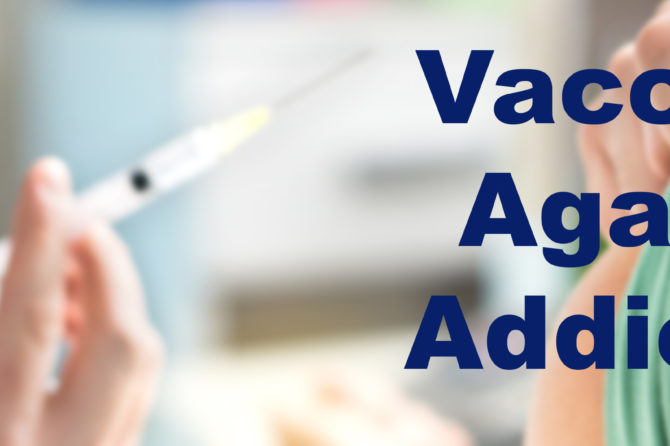
A Vaccine Against Addiction
Addiction is a disease. It ravages the mind, the body, and the soul, prompting the burning question: is there a pharmaceutical cure? Medical science has decimated such past public health scourges as polio and tuberculosis, so how can they formulate a successful escape from substance use?
Search History
For decades, scientists have been seeking pharmacological cures for addiction in many of its various permutations.
- Nicotine Addiction – Patches and gums have been on the prescription market since 1984, and they offer solace by delivering low doses of nicotine into your system, but they don’t block a smoker’s neurotransmitters (which would be more effective in ceasing addiction). However, in 1997 a breakthrough called bupropion hit the scene. This reuptake inhibitor affects your levels of norepinephrine and dopamine, thus rerouting your addiction to nicotine.
- Alcoholism – Almost 50 years ago, scientists formulated a chemical compound known as disulfiram. This substance inhibited the enzymes in your body that help process alcohol, so if you took disulfiram before drinking, it would make you sick. The ensuing nausea was intended to discourage further alcohol intake through negative association, but disulfiram did little to actually control your addictive urges, plus it was harmful to your digestive system. Fast forward to 1994, when a product called naltrexone hit the market. This was more effective in inhibiting the neurotransmitters involved with addictive urges but could be destructive to the liver in high doses.
- Opioid Addiction – Naltrexone has also been instrumental in blocking the effects of certain opioids, thus disrupting the chain of addiction. It was marketed under the brand name Trexan back in 1984 but has since been overshadowed by buprenorphine. Introduced in 2002, buprenorphine is similar to Buprenorphine/Naltrexone, in that it represents a relatively safer substitute for heroin. Thus, it can still be overused, but its effects are weaker than Buprenorphine/Naltrexone and it offers tangential benefits like craving reduction and withdrawal prevention.
The Dire Need for Help
Over the years, medicine has evolved rapidly, but so has substance use. The very pills that offer solace from pain also create a need for more; hence the cycle of abuse has snowballed.
An estimated 52,000 Americans die from drug overdoses each year; that translates to more than one fatality every 10 minutes in this country alone. And of that staggering total, over 42,000 annual deaths are attributed to opioids. This classification of drugs includes heroin, but also its prescription equivalents like oxycodone, hydrocodone, fentanyl, oxymorphone, hydromorphone, and codeine.
The Effects of Opioid Use
When opioids interact with the brain, they create an immediate, two-tiered reaction. Their chemical compositions are designed to comport with our nerve receptors to reduce pain while also increasing pleasure. Just as we become dependant on opioids to treat injuries and chronic maladies, we can also become addicted to the drug, and this effect can last long after the initial pain has subsided. It becomes ingrained in our consciousness as well as our physiology; this “blood-brain barrier” is where researchers are concentrating their renewed focus on a medicinal cure for opioid addiction.
How the New Vaccine Works
Dr. Gary Matyas is pioneering a forthcoming vaccine that is saturated with antibodies. These antibodies are designed to act as a kind of goaltender against the reintroduction of opioids into the system. For example, if someone taking the vaccine should relapse and inject heroin into their blood, the new vaccine would trap the heroin with its high concentration of antibodies. The heroin wouldn’t be allowed to cross into the nervous system, thus negating the “high” normally associated with it. The antibodies bind up the heroin and expel it from the body as waste before it has a chance to do any further damage.
Reducing the Chance of Overdoses
By preventing an individual’s ability to feel the effects of an opioid high, the vaccine would lessen the opportunity for addiction to surge anew. In addition to this revelatory benefit, the vaccine also counteracts the body’s tendency to shut down its respiratory system during an overdose. Many opioid-related deaths are attributed to this tragic turn of events; when heroin (for example) overwhelms its host body, it depresses the lungs to the point where a victim just stops breathing. The antibodies in the prototype vaccine would battle against this heartbreaking eventuality.
Working in Conjunction with Other Remedies
Many people recovering from heroin abuse rely on such aforementioned “substitute” drugs as Buprenorphine/Naltrexone. The new, as yet unnamed, the vaccine would work in conjunction with Buprenorphine/Naltrexone, attacking the addiction on two simultaneous fronts. The Buprenorphine/Naltrexone would supplant the need for heroin on an experiential level while the new vaccine attacks any possible heroin relapse by binding it with antibodies before it attaches to the brain’s receptors.
When Will the Vaccine Be Available?
Although the experimental new vaccine enjoyed a major breakthrough success last December, it has only been tested on rodents thus far. Its antibodies succeeded in binding with opioids before they reached the “blood-brain barrier” and it didn’t interfere with buprenorphine or Buprenorphine/Naltrexone use. However, human experimentation is still years away, and the new vaccine will need massive funding efforts to reach the next stages.
Leave a reply